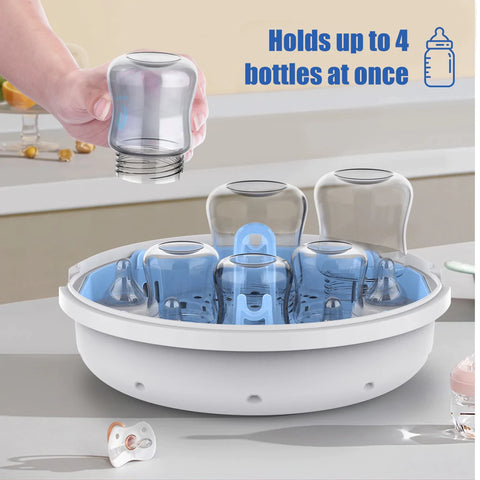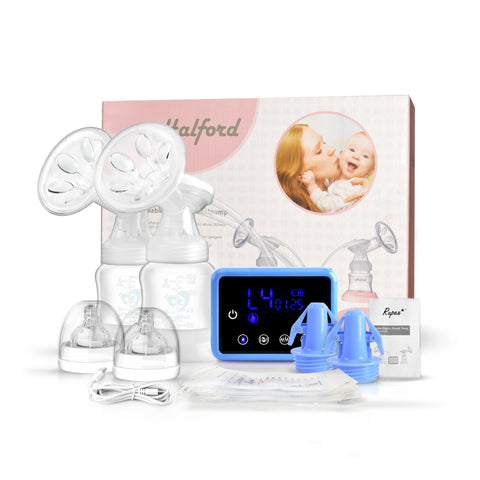After pumping, cleaning all of your pump's components and bottles may be time-consuming. How frequently should breast pump components be sterilized? And how should it be done the best? What you should know is as follows.

How Frequently Should Breast Pump Parts Be Sterilized?
Thankfully, you don't need to sterilize your pump components after every pumping session. Sanitize feeding supplies at least once a day to reduce germs' spread further. Sanitation is crucial when your infant is under three months old, was born early, or has a compromised immune system. Older, healthier infants may not need daily sanitization if feeding utensils are thoroughly cleaned after each use.
In light of that, I would advise the following:
· If your child is under three months old, a preemie, or ill, sterilize them daily.
· If your child is full-term, healthy, and more than three months old, sterilize every few days.
Note: Microwave Sterilizer is necessary to sterilize breast pump parts.

How to Clean Breast Pump Components
The good news is that sanitizing pump components don't require much work. The wash basin, bottle brush, and pump components may all be sterilized in one of the three methods listed below, from simplest to harshest.
Note: Before beginning the procedure, disassemble, clean, and rinse your pump components. Read the manufacturer's directions for cleaning the parts on your pump.
- 1. Use a sterilizer
Clean bottles and pump components are placed inside a sterilizer, which uses steam to disinfect them.
- 2. Microwave Steam Bag
Your pump components may be sterilized in a microwave steam bag or container, which is the following simplest method. To use these bags, you typically add water to the bag or container containing your pump components, seal it, and microwave it for the allotted time. Make careful to adhere to the directions printed on the bag.
It will be hot when you open the bag, so be careful not to burn yourself. After allowing the water and air to escape, move the pump components to a clean towel and let them air dry.
- 3. Dishwasher
You don't need to wash your pump components in advance if you use the dishwasher. Place the pump components in the dishwasher's basket and run a hot water cycle with a heated drying or sanitizing option to clean them.

How do you clean the tube on a breast pump?
-
1. Always use clean hands and avoid germs on the pump tubing:
Before you start pumping or cleaning your pump, wash your hands and groom them. They must be cleaned in a bowl of warm soapy water, scrubbed for at least 20 seconds and finally rinsed. Every time you handle your pump, follow these steps. Use a new towel or paper towel each time you wipe clean or dry the countertops or any other surfaces that will come into touch with it.
-
2. Check your breast pump every time you use it:
Take it apart before each usage to ensure that none of the bottles, tubing, or other components has developed mould. Before operating the pump again, replace any questionable parts as soon as possible. Keep an extra set of tubes and features available if you suddenly need to repair anything. It is preferable to replace any affected items since mould is tough to clean and eradicate.
How often to replace the breast pump parts?
Breast pump components deteriorate with time. The suction of your pump may be impacted, resulting in less milk produced. Here is how frequently you should replace the components on your breast pump to prevent problems with your milk supply.
However, as this can vary between brands, it's a good idea to check with your breast pump manufacturer to confirm how frequently they recommend replacement.
-
1. Duckbills (duck valves):
They are composed of silicone, and each time the pump motor pulls at the valve, they stretch and then release, generating the suction required to collect breast milk from your breasts. One of the first things you should attempt if your breast pump loses suction is to replace the valves.
﹡If you pump three or more times daily, you should change duck valves once a month.
﹡Replace every two to three months if you pump less than three times daily.
﹡If you pump three or more times daily, you should replace the valve membranes every two to four weeks.
﹡Replace every two months if you only pump once every three hours.
-
2.Backflow protectors:
stop moisture and breast milk from getting into your tubing. Not all pumps come with backflow preventers.
If you pump three or more times daily, you should replace backflow protectors every three months. Replace every six months if you only pump once every three hours.
-
3.Flanges (also known as breast shields and connectors):
They are the components that fasten to your breasts. (Take note that you might require a size other than the one included with your pump). The parts that join your breast shields to your valves, tubing, and backflow preventers are known as connectors.
Residue can occasionally accumulate on these pump components, especially in difficult-to-reach places on connectors. This buildup may compromise the pump's efficiency.
Breast shields should be changed every six months or immediately if you see any tears or cracks.
-
4.Tubings:
These link your pump's motor, components, and bottles together.
Depending on the pump's maker, different tubing should be handled. If breast milk or other moisture gets into the pump, for instance, the Spectra tubing has to be changed every once since it might harm the motor.
( How often to replace Tubing: If milk or moisture seeps into the tubing of a closed system pump or if tubing slips on and off easily when you're not moving about. )

How long is expressed milk preserved?
Depending on the storage technique, you may retain extracted breast milk for some time. Consider these broad principles:
- ✅ Room Temperature: It is OK to leave breast milk out of the refrigerator for six hours before being consumed. Breast milk should be used or preserved adequately within four hours if the temperature is over 86 degrees Fahrenheit.
- ✅ Insulated Cooler: Breast milk that has just been expressed may be kept in a refrigerator for up to one day at a time; it is refrigerated and has ice packs.
- ✅ Refrigerator: Breast milk that has just been expressed may be kept in a clean environment for up to four days in the refrigerator's back. It's best to use or freeze the milk within three days.
- ✅ Deep freezer: Freshly expressed breast milk may be kept for up to 12 months in the back of a deep freezer. To get the most out of the frozen milk, utilize it within the first six months.
Remember that studies show that the amount of vitamin C in breast milk decreases the longer it is kept in the freezer or refrigerator.
Additionally, it's crucial to remember that your breast milk adapts to your baby's needs. When a baby is a few months older, breast milk expressed when the baby is a newborn won't completely meet the same baby's needs. Additionally, storage recommendations for premature, ill, or hospitalized infants may vary.
More Tips
Breast milk should be chilled, refrigerated, or frozen as soon as it is expressed.
In a clean, covered container, expressed milk can stay at room temperature for four to six hours if left without refrigeration. Milk should be thrown away if it has been out longer.
Expressed breast milk should always be thrown out if you're unsure how long it's been. Although it can be challenging to discard breast milk that has been expressed (after all that labour!), keep in mind that your baby's health comes first.








